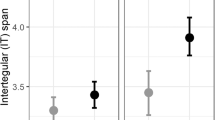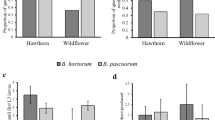Abstract
Worldwide trade in non-native bumblebees remains largely unrestricted despite well-documented cases where introductions of non-native bees have gone dramatically wrong. Within Europe, indiscriminate importation of non-native populations of bumblebees (Bombus terrestris) for the pollination of glasshouse crops continues on a massive scale. However, no risk assessment has been conducted for these introductions, perhaps because B. terrestris is considered a native species, so shipping populations from one region to another has been implicitly assumed to present no risk. This view is clearly unjustified because Bombus terrestris populations differ significantly in their genetic makeup as demonstrated by strong differences in coat colour and behavioural traits. Therefore, for the first time we compare an important competitive trait, namely foraging performance, between commercially available B. terrestris populations in contrasting environments. We test whether commercially reared populations differ in their nectar foraging performance and whether this is influenced by both their source environment and the one they are introduced into. We do this by means of a reciprocal transplant experiment. Strong, consistent inter-population differences in performance occurred irrespective of test location: Canary Island bees (B. t. canariensis) were superior to Sardinian bees (B. t. sassaricus), which were generally superior to mainland European bees (B. t. terrestris). These inter-population differences in performance were largely explained by inter-population variation in forager size, with larger bees being superior foragers. However, even when body size was accounted for, “native” bees were not superior to transplanted non-native bees in all but one case. We conclude that non-native populations, especially those with large foragers, can be highly competitive foragers. This could lead to their establishment and displacement of native bees. Therefore, we recommend that unregulated movements of non-native B. terrestris populations within Europe should not be carried out without a full risk assessment.


Similar content being viewed by others
References
Alford DV (1975) Bumblebees. Davis-Poynter, London
Allen T, Cameron S, McGinley R, Heinrich B (1978) The role of workers and new queens in the ergonomics of a bumblebee colony (Hymenoptera: Apoidea). J Kans Entomol Soc 51:329–342
Beekman M, van Stratum P, Lingeman R (1998) Diapause survival and post-diapause performance in bumblebee queens (Bombus terrestris). Entomol Exp Et Appl 89:207–214
Brown JH, Lomolino MV (1998) Biogeography, 2nd edn. Sinauer, Sunderland
Buttermore RE, Pomeroy N, Hobson W, Semmens T, Hart R (1998) Assessment of the genetic base of Tasmanian bumble bees (Bombus terrestris) for development as pollination agents. J Apicult Res 37:23–25
Carruthers S (2003) Plight of the bumblebee. Practic Hydropon Greenhouses 69:23–30
Carruthers S (2004) A bee’s eye view. Practical hydroponics and greenhouses 77:URL http://www.hydroponics.com.au/back_issues/issue77.html
Carvell C (2002) Habitat use and conservation of bumblebees (Bombus spp.) under different grassland management regimes. Biol Conserv 103:33–49
Case TJ (1978) A general explanation for insular body size trends in terrestrial vertebrates. Ecology 59:1–18
Chittka L, Wells H (2004) Color vision in bees: mechanisms, ecology and evolution. In: Prete F (ed) How simple nervous systems create complex perceptual worlds. MIT Press, Boston, pp 165–191
Chittka L, Ings TC, Raine NE (2004) Chance and adaptation in the evolution of island bumblebee behaviour. Popul Ecol 46:243–251
De Jonge R (1986) Crossing experiments with Bombus terrestris terrestris (Linnaeus,1758) and Bombus terrestris xanthopus (Kriechbaumer, 1870) and some notes on diapause and nosemose (Nosema) (Hymenoptera, Apoidea). Phegea 14:19–23
Diniz NM, Soares AEE, Sheppard WS, Del Lama MA (2003) Genetic structure of honeybee populations from southern Brazil and Uruguay. Genet Mol Biol 26:47–52
Edwards M (2001) UK BAP bumblebee working group report. Unpublished report for the UK BAP Bumblebee Working Group, Midhurst
Estoup A, Solignac M, Cornuet J-M, Goudet J, Scholl A (1996) Genetic differentiation of continental and island populations of Bombus terrestris (Hymenoptera: Apidae) in Europe. Mol Ecol 5:19–31
Fitter AH, Fitter RSR (2002) Rapid changes in flowering time in British plants. Science 296:1689–1691
Foster JB (1964) The evolution of mammals on islands. Nature 202:234–235
Goka K, Okabe K, Yoneda M, Niwa S (2001) Bumblebee commercialization will cause worldwide migration of parasitic mites. Mol Ecol 10:2095–2099
Goulson D (2003) Effects of introduced bees on native ecosystems. Annu Rev Ecol Evol Syst 34:1–26
Goulson D, Darvill B (2004) Niche overlap and diet breadth in bumblebees; are rare species more specialized in the choice of flowers? Apidologie 35:55–63
Goulson D, Hughes WOH, Derwent LC, Stout JC (2002a) Colony growth of the bumblebee, Bombus terrestris, in improved and conventional agricultural and suburban habitats. Oecologia 130:267–273
Goulson D, Peat J, Stout JC, Tucker J, Darvill B, Derwent LC, Hughes WOH (2002b) Can alloethism in workers of the bumblebee, Bombus terrestris, be explained in terms of foraging efficiency? Anim Behav 64:123–130
Hergstrom K, Buttermore R, Seeman O, McCorkell B (2002) Environmental research on the impact of bumblebees in Australia and facilitation of national communication for/against further introduction. In: Horticulture Australia Project No: VG99033. Horticulture Australia Ltd, Sydney, and Tasmanian Museum and Art Gallery, Hobart
Hingston AB, McQuillan PB (1999) Displacement of Tasmanian native megachilid bees by the recently introduced bumblebee Bombus terrestris (Linnaeus, 1758) (Hymenoptera: Apidae). Aust J Zool 47:59–65
Hingston AB, Marsden-Smedley J, Driscoll DA, Corbett S, Fenton J, Anderson R, Plowman C, Mowling F, Jenkin M, Matsui K, Bonham KJ, Ilowski M, McQuillan PB, Yaxley B, Reid T, Storey D, Poole L, Mallick SA, Fitzgerald N, Kirkpatrick JB, Febey J, Harwood AG, Michaels KF, Russell MJ, Black PG, Emmerson L, Visoiu M, Morgan J, Breen S, Gates S, Bantich MN, Desmarchelier JM (2002) Extent of invasion of Tasmanian native vegetation by the exotic bumblebee Bombus terrestris (Apoidea: Apidae). Aust Ecol 27:162–172
Hulme M, Jenkins GJ, Lu X, Turnpenny JR, Mitchell TD, Jones RG, Lowe J, Murphy JM, Hassell D, Boorman P, McDonald R, Hill S (2002) Climate Change Scenarios for the United Kingdom. In: The UKCIP02 scientific report. Tyndall Centre for Climate Change Research, School of Environmental Sciences. University of East Anglia, Norwich, UK, p 120
Kawecki TJ, Ebert D (2004) Conceptual issues in local adaptation. Ecol Lett 7:1225–1241, DOI: 10.1111/j.1461–0248.2004.00684x
Kolar CS, Lodge DM (2001) Progress in invasion biology: predicting invaders. Trends Ecol Evol 16:199–204
Lomolino MV (1985) Body size of mammals on islands: the island rule reexamined. Am Nat 125:310–316
Mand M, Mand R, Williams IH (2002) Bumblebees in the agricultural landscape of Estonia. Agr Ecosyst Environ 89:69–76
Matsumura C, Nakajima M, Yokoyama J, Washitani I (2004) High reproductive ability of an alien bumblebee invader, Bombus terrestris L., in the Hidaka region of southern Hokkaido, Japan. Jpn J Conserv Ecol 9:93–102
McKinney ML, Lockwood JL (1999) Biotic homogenization: a few winners replacing many losers in the next mass extinction. Trends Ecol Evol 14:450–453
Moller H (1996) Lessons for invasion theory from social insects. Biol Conserv 78:125–142
Morandin LA, Laverty TM, Kevan PG, Khosla S, Shipp L (2001) Bumble bee (Hymenoptera: Apidae) activity and loss in commercial tomato greenhouses. Can Entomol 133:883–893
Olden JD, LeRoy Poff N, Douglas MR, Douglas ME, Fausch KD (2004) Ecological and evolutionary consequences of biotic homogenization. Trends Ecol Evol 19:18–24
Oldroyd BP (1999) Coevolution while you wait: Varroa jacobsoni, a new parasite of western honeybees. Trends Ecol Evol 14:312–315
Palmer M (2002) Testing the ’island rule’ for a tenebrionid beetle (Coleoptera, Tenebrionidae). Acta Oecologica Int J Ecol 23:103–107
Pelletier L, McNeil JN (2003) The effect of food supplementation on reproductive success in bumblebee field colonies. Oikos 103:688–694
Rasmont P (1997) Ecologie et distribution de Bombus terrestris (L.) dans la region mediterraneenne. In: XXXV Congres International d’Apiculture, 1997, pp 178–179
R Development Core Team (2004) R: a language and environment for statistical computing. In: R foundation for statistical computing. Vienna, Austria
Ruz L, Herrera R (2001) Preliminary observations on foraging activities if Bombus dahlbomii and Bombus terrestris (Hym: Apidae) on native and non-native vegetation in Chile. Acta Hort 561:165–169
Schmid-Hempel R, Schmid-Hempel P (1998) Colony performance and immunocompetence of a social insect, Bombus terrestris, in poor and variable environments. Funct Ecol 12:22–30
Spaethe J, Chittka L (2003) Interindividual variation of eye optics and single object resolution in bumblebees. J Exp Biol 206:3447–3453
Spaethe J, Weidenmüller A (2002) Size variation and foraging rate in bumblebees (Bombus terrestris). Insect Soc 49:142–146
Stout JC, Kells AR, Goulson D (2002) Pollination of the invasive exotic shrub Lupinus arboreus (Fabaceae) by introduced bees in Tasmania. Biol Conserv 106:425–434
Velthuis HHW (2002) The historical background of the domestication of the bumble-bee, Bombus terrestris, and its introduction in agriculture. In: Kevan P, Imperatriz Fonseca VL (eds) Pollinating bees—the conservation link between agriculture and nature. Ministry of Environment, Brazil, pp 177–184
Widmer A, Schmid-Hempel P, Estoup A, Scholl A (1998) Population genetic structure and colonization history of Bombus terrestris s.l. (Hymenoptera: Apidae) from the Canary Islands and Madeira. Heredity 81:563–572
Acknowledgements
This research was supported by grants Ch147/3-1 from the DFG, NER/A/S/2003/00469 from NERC and BES SEPG 2267. Sincere thanks go to Dr Nigel Raine, Nicola Ward, Dr Steffan-Dewenter and the three anonymous referees for constructive comments on earlier versions of this manuscript. Statistical advice was kindly given by Rob Knell. We would also like to thank Tonia Schamberger, Petra Frauenstein, Georgia Erdmann, Alexander Funk, Simone Geyer, Ina Heidinger, Korinna Pohl, Frank Hartmann, Arne Guicking, Adrienne Gerber-Kurz, Adelheid Langenbeck, Marco Piu, Luigi Manias, Gianna Mura and Ralph Stelzer for help with the experiments. All experiments conformed with the laws of the countries where they were performed.
Author information
Authors and Affiliations
Corresponding author
Additional information
Communicated by Ingolf Steffan-Dewenter
Rights and permissions
About this article
Cite this article
Ings, T.C., Schikora, J. & Chittka, L. Bumblebees, humble pollinators or assiduous invaders? A population comparison of foraging performance in Bombus terrestris . Oecologia 144, 508–516 (2005). https://doi.org/10.1007/s00442-005-0081-9
Received:
Accepted:
Published:
Issue Date:
DOI: https://doi.org/10.1007/s00442-005-0081-9




